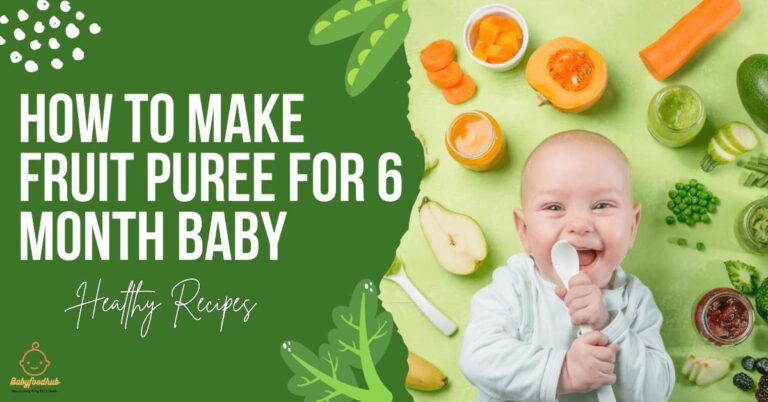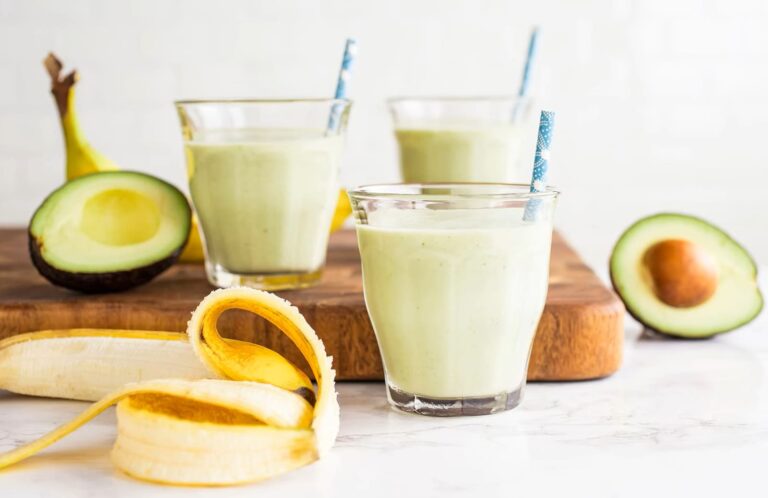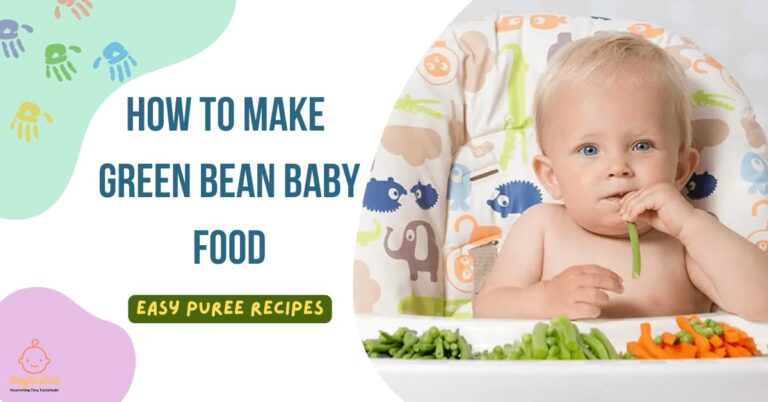What is a Healthy Toddler Meal?
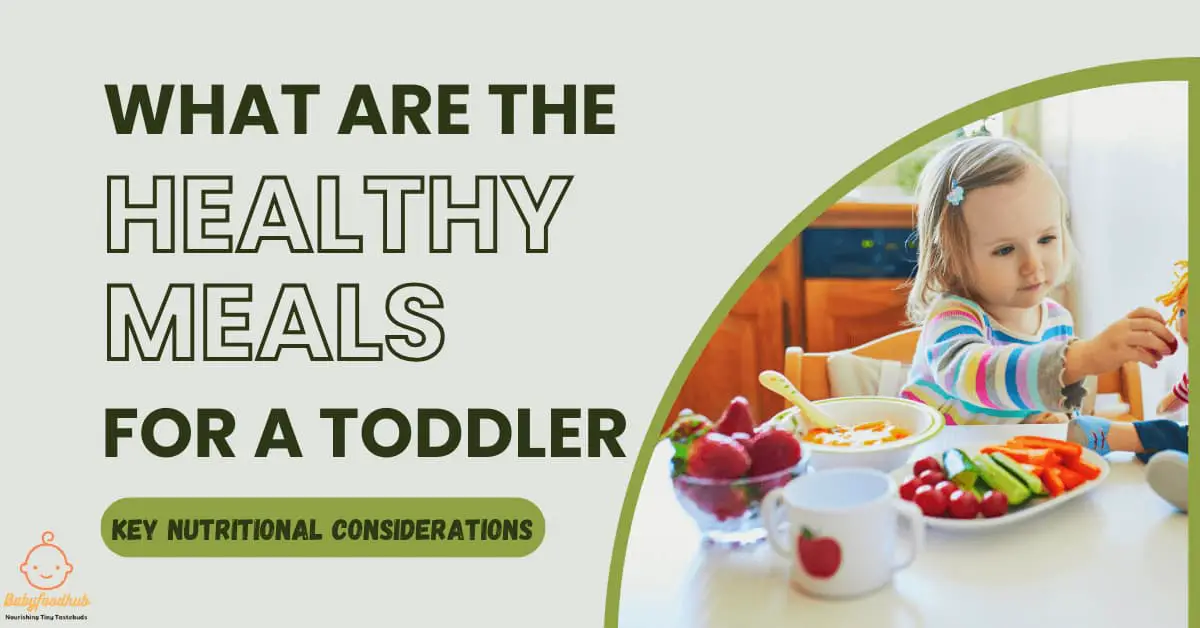
A healthy toddler meal is a nutritious and balanced meal that promotes the optimal growth and development of toddlers. These meals should include a variety of foods from different food groups, such as fruits, vegetables, whole grains, lean proteins, and healthy fats, in appropriate portion sizes to meet the nutritional needs of a growing toddler.
By providing a wide range of nutrients, vitamins, and minerals, healthy toddler meals support the development of a strong immune system, healthy bones and muscles, cognitive function, and overall well-being. It is important to introduce and expose toddlers to a diverse range of flavours and textures to encourage healthy eating habits and prevent picky eating behaviours.
Key Nutritional Considerations For Toddlers

A healthy toddler meal should be well-balanced, providing key nutritional considerations. It should include a variety of food groups such as fruits, vegetables, whole grains, proteins, and dairy to support their growth and development.
- Toddlers require protein for healthy growth and development. Here are a few points to consider regarding their protein intake:
- Include protein sources such as lean meats, poultry, fish, eggs, and dairy products in your toddler’s meals.
- Opt for age-appropriate portion sizes to provide adequate protein without overloading their little tummies.
- Distribute protein sources throughout the day to ensure a steady supply of essential amino acids.
- Offer plant-based protein options like legumes, tofu, and quinoa to cater to vegetarian or vegan preferences.
- Consult a paediatrician or a registered dietitian for guidance on your toddler’s specific protein needs.
Essential Micronutrients
- Micronutrients play a vital role in supporting your toddler’s overall health and well-being. Here are some essential micronutrients to include in their meals:
- Iron: Ensure your toddler’s diet contains iron-rich foods like lean meats, fortified cereals, beans, and spinach to support healthy blood production.
- Calcium: Offer dairy products or calcium-fortified alternatives like fortified plant-based milk to promote strong bones and teeth.
- Vitamin D: Help your toddler absorb calcium by including sources like fatty fish, fortified dairy products, and safe sun exposure (with sunscreen).
- Vitamin C: Enhance iron absorption by pairing iron-rich foods with vitamin C sources like citrus fruits, berries, and bell peppers.
- Omega-3 fatty acids: Include sources like fatty fish, chia seeds, and walnuts to support brain and eye development.
Fiber-rich Foods
Fiber is essential for your toddler’s digestive health and aids in preventing constipation. Here’s how you can incorporate fiber-rich foods into your meals:
- Offer a variety of fruits and vegetables, such as apples, bananas, carrots, and broccoli, which are high in fiber.
- Choose whole grains like whole wheat bread, brown rice, and whole grain cereals over refined options to increase fiber intake.
- Include legumes like lentils, chickpeas, and black beans as additional sources of fiber and protein.
- Ensure your toddler drinks enough water throughout the day to help fiber move smoothly through their digestive system.
- Introduce fiber gradually to prevent any discomfort or digestive issues.
Remember, providing a balanced and varied diet is essential for meeting your toddler’s nutritional needs. Be sure to consult with a healthcare professional to tailor their meals to their specific dietary requirements.
Health Benefits Of A Balanced Toddler Diet

A balanced toddler diet provides numerous health benefits, supporting the child’s growth and development. Offering a variety of nutrient-rich foods, such as fruits, vegetables, whole grains, and lean proteins, ensures a healthy meal for toddlers.
A balanced toddler diet plays a crucial role in promoting growth and development, supporting cognitive function, and boosting the immune system. By offering a variety of nutritious foods, you can ensure that your little one receives the essential nutrients they need at this important stage of life.
Let’s explore the key health benefits of a well-rounded toddler meal:
Promotes Growth And Development
- Protein-rich foods, such as lean meats, fish, eggs, and legumes, provide the building blocks for growth and help build strong muscles.
- Calcium-rich foods, including dairy products, tofu, and leafy greens, contribute to the development of healthy bones and teeth.
- Whole grains, like oats and brown rice, supply the necessary carbohydrates for energy, ensuring optimal physical growth.
Supports Cognitive Function
- Omega-3 fatty acids, found in fatty fish such as salmon, as well as flaxseeds and walnuts, are essential for brain development and improving cognitive function.
- Fruits and vegetables rich in antioxidants, such as berries and leafy greens, help protect brain cells against oxidative stress, supporting better cognitive abilities.
- Iron-rich foods, like lean meats and fortified cereals, aid in the formation of red blood cells that carry oxygen to the brain, facilitating cognitive processes.
Boosts Immune System
- Vitamin C-rich fruits, such as oranges, strawberries, and kiwis, strengthen the immune system and protect against common illnesses.
- Zinc, found in foods like lean meats, whole grains, and legumes, supports the immune system and aids in the healing process.
- Probiotic-rich foods, such as yoghurt and fermented foods, promote a healthy gut and strengthen the immune system’s response to infections.
By focusing on these health benefits and offering a wide variety of nutrient-dense foods, you can ensure that your toddler receives the essential nutrients they need for optimal growth, development, and overall well-being.
Age-Appropriate Portions And Serving Sizes
A healthy toddler meal is about providing age-appropriate portions and serving sizes to meet their nutritional needs while promoting good eating habits. Ensure their meals include a balance of fruits, vegetables, whole grains, and protein sources like lean meat or beans.
Determining Portion Sizes For Toddlers
When it comes to feeding your toddler, it’s important to ensure they are getting the right amount of food to support their growing bodies. Determining portion sizes for toddlers can sometimes be a challenge, especially when they have small appetites or seem to never stop eating.
Here are some guidelines to help you determine age-appropriate portion sizes for your little one:
- Keep portion sizes small: Toddlers have small stomachs and may not eat as much as older kids or adults. Start with small portions and let your child ask for more if they’re still hungry. Remember, they can always have seconds if they want!
- Use your child’s appetite as a guide: Pay attention to your child’s hunger cues and adjust portion sizes accordingly. Some days they may eat more, while other days they may eat less. Trust their appetite and avoid pressuring them to finish everything on their plate.
- Use hand measurements: A quick and easy way to estimate portion sizes is by using your child’s hand as a guide. For example:
- One serving of protein (such as meat, chicken, or fish) is roughly the size of your child’s palm.
- One serving of grains (such as rice or pasta) is about the size of their fist.
- One serving of fruits or vegetables is about the size of their cupped hand.
- Serve a variety of foods: Offering a variety of nutrient-dense foods is key to a healthy toddler meal. Aim to include a mix of protein, whole grains, fruits, vegetables, and healthy fats in their meals. This will help ensure they’re getting a good balance of macronutrients.
- Avoid restrictive portion control: While portion sizes are important, it’s also important not to restrict your child’s food intake too much. Toddlers need a variety of nutrients to support their growth and development. Instead of focusing solely on portion control, focus on providing nutrient-dense foods and letting your child eat until they’re satisfied.
By following these guidelines and paying attention to your child’s hunger cues, you can ensure that they’re getting the appropriate portion sizes for their age and needs. Remember, every child is different, so it’s important to be flexible and adjust portion sizes as needed.
Incorporating A Variety Of Food Groups
A healthy toddler meal incorporates a variety of food groups to ensure balanced nutrition and promote growth and development. Including fruits, vegetables, whole grains, lean proteins, and dairy products can provide essential vitamins and minerals for your child’s well-being.
Introduction To Different Food Groups
A variety of food groups is essential for ensuring a healthy toddler meal. Including different food groups in your child’s diet helps provide them with all the necessary nutrients for their growth and development. Let’s explore the various food groups and how they contribute to a balanced meal.
Planning Balanced Meals
To create well-rounded meals, it’s important to incorporate foods from different groups. Here are the key food groups to consider:
- Grains: Including whole grains like oatmeal, whole wheat bread, or brown rice provides your toddler with essential carbohydrates, fiber, and B vitamins.
- Proteins: Lean meat, poultry, fish, beans, and eggs are excellent sources of protein, promoting muscle development and supporting overall growth.
- Dairy: Dairy products such as milk, cheese, and yoghurt supply calcium and vitamin D for strong bones and teeth.
- Fruits: Fruits offer a variety of vitamins, minerals, and fiber. Incorporate a range of colours like berries, bananas, oranges, and melons to ensure a broad nutrient intake.
- Vegetables: Vegetables like broccoli, carrots, spinach, and bell peppers are rich in vitamins, minerals, and antioxidants. Aim for different colours and textures to provide diverse nutrients.
- Healthy Fats: Avocados, nut butter, and olive oil offer essential fatty acids necessary for brain development. Include these healthy fats in moderation.
By combining foods from these groups, you can create balanced meals that cater to your toddler’s nutritional needs. For example:
- Whole wheat bread (grains) with turkey slices (proteins) and lettuce (vegetables).
- Scrambled eggs (proteins) with spinach (vegetables) and whole-grain toast (grains).
- Grilled chicken (proteins) with brown rice (grains) and steamed broccoli (vegetables).
Remember, variety is key to providing a wide range of nutrients essential for your toddler’s health and well-being. Encouraging exploration of different food groups will help develop their taste preferences and promote healthier eating habits.
Healthy Ingredients And Recipe Ideas
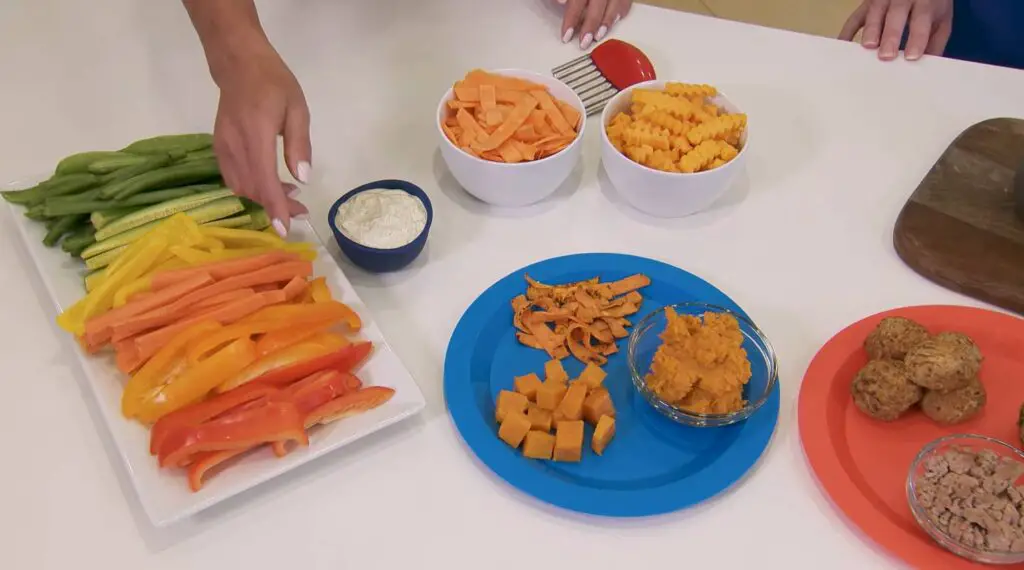
Looking for healthy toddler meal ideas? Discover nutritious ingredients and recipe inspiration for your little one’s meals. From colourful fruits and vegetables to lean proteins and whole grains, find the perfect balance for your toddler’s well-being.
Incorporating Fruits And Vegetables
Including fruits and vegetables in your toddler’s meals is essential for their overall health and development. These nutritious ingredients provide vitamins, minerals, and fiber that support their growing bodies. Here are some easy ways to incorporate fruits and vegetables into their meals:
- Offer a variety of colorful fruits and vegetables to keep meals interesting and provide a range of nutrients.
- Create fun and visually appealing meals by cutting fruits and vegetables into different shapes and sizes.
- Incorporate fruits and vegetables into smoothies by blending them with yoghurt or milk for a refreshing and nutritious drink.
- Add finely chopped or pureed vegetables such as spinach or carrots to sauces, soups, and casseroles for added nutrition.
- Include fruits and vegetables as toppings for whole grain pancakes, waffles, or oatmeal to boost their nutritional value.
- Offer fresh fruit as a snack or dessert option instead of processed sweets.
By incorporating a variety of fruits and vegetables into your toddler’s meals, you can ensure they receive the necessary nutrients for their growth and development.
Whole Grains And High-Fiber Foods
Whole grains and high-fiber foods are important for your toddler’s digestive health and provide essential nutrients like complex carbohydrates, fiber, and B vitamins. Here are some ways to include them in your toddler’s meals:
- Choose whole-grain cereals, bread, and pasta over refined grains. Look for labels that specify “whole grain” or “100% whole wheat.”
- Offer oatmeal or whole grain cereals with milk and fruits as a nutritious breakfast option.
- Use whole-grain flour when baking muffins, pancakes, or bread to increase the fiber content.
- Serve quinoa, brown rice, or whole wheat couscous as side dishes instead of white rice or pasta.
- Include beans, lentils, and chickpeas in soups, stews, or salads for a good source of fibre and plant-based protein.
- Offer snacks like whole grain crackers, popcorn, or homemade granola bars made with oats, nuts, and dried fruits.
By incorporating whole grains and high-fibre foods into your toddler’s meals, you can promote healthy digestion and provide them with the energy they need to grow and thrive.
Healthy Protein Sources
Including healthy protein sources in your toddler’s meals is important for their muscle development and overall growth. Here are some ideas to incorporate protein-rich foods into their diet:
- Offer lean meats such as chicken, turkey, or fish as part of their main course. Be sure to cook them in a healthy way, such as baking or grilling, to avoid excess oil or fat.
- Include eggs in their meals, such as omelettes, scrambled eggs, or egg muffins. Eggs are a great source of high-quality protein.
- Use tofu or tempeh as a plant-based protein option in stir-fries or as a substitute for meat in recipes.
- Offer dairy products such as yoghurt, cheese, or milk, which provide both protein and calcium.
- Include legumes like beans, lentils, and chickpeas in various dishes, such as soups, salads, or dips.
- Try nut butter, such as peanut or almond butter, as spreads on whole grain toast or as a dip for fruits and vegetables.
By incorporating these healthy protein sources into your toddler’s meals, you can ensure they receive the necessary nutrients for their growth and development.
Remember, providing a variety of nutrient-rich ingredients in your toddler’s meals is key to promoting their overall health and well-being.
Avoiding Common Food Allergens And Harmful Ingredients
A healthy toddler meal includes avoiding common food allergens and harmful ingredients to promote their overall well-being. By being mindful of potential allergens and unhealthy additives, parents can ensure their child’s nutrition and reduce the risk of allergic reactions or negative health effects.
Recognizing Common Allergens
When preparing meals for toddlers, it’s essential to be aware of common food allergens that can potentially cause adverse reactions. Here are some of the most common allergens to watch out for:
- Dairy products: Many toddlers have lactose or milk protein intolerance, so it’s important to opt for dairy-free alternatives such as almond or oat milk.
- Eggs: Eggs are a common allergen among toddlers. Look for suitable substitutes like flaxseed or applesauce when baking.
- Peanuts and tree nuts: These nuts can cause severe allergic reactions. Use caution when introducing new foods and carefully read product labels.
- Wheat and gluten: Some toddlers may have allergies or sensitivities to wheat and gluten. Experiment with alternative grains like quinoa or rice.
- Soy: Soy allergies are prevalent among toddlers. Be cautious when including soy-based products in your meals.
- Fish and shellfish: Seafood allergies are common. Ensure that there is no cross-contamination when preparing meals.
Reading Food Labels
To avoid allergens and harmful ingredients, you must become adept at reading food labels. Here’s what to look for when analyzing product labels:
- Allergen statements: Manufacturers often indicate if their product contains common allergens. Look for phrases such as “contains milk” or “may contain nuts” to avoid unwanted allergens.
- Ingredient list: Familiarize yourself with the ingredient list and identify any potential allergens. If your toddler has specific allergies, make sure to check for them.
- Additives and preservatives: Try to avoid processed foods with excessive additives and preservatives. Opt for fresh and natural ingredients as much as possible.
- Hidden sources: Some ingredients can be hidden under different names. For example, milk can also be listed as casein or lactose. Be vigilant in identifying these hidden allergens.
Minimizing Added Sugars And Sodium
Another crucial aspect of a healthy toddler meal is minimizing added sugars and sodium. Here’s why it’s important and how you can achieve this:
- Excessive sugar intake can lead to obesity and dental problems. Limit sugary snacks and opt for fresh fruits instead.
- Be mindful of hidden sugars in processed foods, such as flavoured yoghurts or fruit juices. Check the nutrition label for sugar content and opt for alternatives with less added sugars.
- Sodium intake should be limited in toddlers, as high sodium levels can contribute to high blood pressure. Choose low-sodium options and limit the use of salt during meal preparation.
By avoiding common allergens and harmful ingredients, you can ensure that your toddler’s meals are healthy and safe. Reading food labels and being conscious of added sugars and sodium will contribute to their overall well-being. Remember to consult with a healthcare professional if your child has specific food allergies or dietary restrictions.
Creating A Positive Dining Environment
A healthy toddler meal contributes to creating a positive dining environment, promoting their growth and well-being. Focus on nutrient-rich foods, including fruits, vegetables, lean proteins, and whole grains to ensure their optimal development.
When it comes to creating a positive dining environment for your toddler, there are a few key factors to consider. By establishing a routine and setting the stage for mealtime, you can make mealtimes more enjoyable and encourage healthy eating habits.
Here are some tips to help you create a positive dining environment for your little one:
Establishing A Routine:
- Set consistent meal and snack times: Establish regular times for meals and snacks to help your toddler develop a sense of routine and expectation around eating.
- Offer a variety of foods: Introduce different types of foods to your toddler and encourage them to try new flavours and textures. This will help expand their palate and promote a well-rounded diet.
- Serve meals at the table: Encourage your toddler to eat at the table rather than in front of the TV or while playing. This will help them focus on their food and develop good eating habits.
- Limit distractions: Minimize distractions during mealtime, such as electronic devices or noisy environments. Create a calm and peaceful atmosphere to promote mindful eating.
Setting The Stage For Mealtime:
- Use positive language: When discussing food and mealtimes with your toddler, use positive and encouraging language. Avoid labeling foods as “good” or “bad” and instead focus on the importance of nourishing their bodies.
- Involve your toddler in meal preparation: Engage your little one in meal preparation by letting them help with simple tasks like washing vegetables or stirring ingredients. This can increase their interest in food and make them more likely to try new things.
- Create an appealing dining environment: Make mealtimes enjoyable by setting a visually pleasing table, using colorful plates and utensils, and incorporating fun placemats or tablecloths. This can make mealtime feel special and exciting for your toddler.
- Lead by example: Be a positive role model by eating a variety of healthy foods yourself. Your toddler is more likely to mimic your eating behaviors, so make sure to choose nutritious options during meals.
Establishing a routine and setting the stage for mealtime can significantly impact your toddler’s eating habits. By following these tips, you can create a positive dining environment that promotes healthy eating and fosters a positive relationship with food. Remember to be patient and persistent as your little one develops their own taste preferences and eating habits.
Enjoying meals together as a family can also help create a positive and lasting connection with food for your toddler.
Promoting Independence And Active Participation
Promote independence and active participation in your toddler’s mealtime with healthy and nutritious meals that are tailored to their needs. Encourage them to explore and engage with different food groups, making mealtime a fun and educational experience.
Self-Feeding Techniques:
Encouraging self-feeding is an essential aspect of promoting independence in toddlers. It allows them to develop fine motor skills and gain confidence in their abilities. Here are a few self-feeding techniques to promote independence:
- Start by offering finger foods that are easy to pick up and hold, such as small pieces of soft fruits or cooked vegetables.
- Provide child-sized utensils that are easy to grip, like small spoons and forks.
- Allow your toddler to practice using their utensils even if it gets messy. This helps them learn to navigate their utensils and develop hand-eye coordination.
- Provide opportunities for your toddler to feed themselves during meals. Offer foods that can be easily scooped or stabbed with a utensil, like mashed potatoes or pasta.
- Gradually increase the complexity of the foods you offer, challenging your toddler to use different techniques to eat them.
Encouraging Food Exploration:
Food exploration plays a crucial role in developing a healthy relationship with food. It allows toddlers to explore different tastes, textures, and colours while developing their preferences. Here are some ways to encourage food exploration:
- Offer a variety of foods from different food groups, including fruits, vegetables, whole grains, and lean proteins.
- Introduce new foods gradually, allowing your toddler to become familiar with them before expecting them to eat.
- Encourage your toddler to touch, smell, and play with their food before tasting it. This helps them become more comfortable with new textures and flavours.
- Make mealtime an interactive experience by involving your toddler in meal preparation. Let them help with simple tasks like stirring ingredients or tearing lettuce leaves.
- Use positive reinforcement and praise your toddler when they try new foods, even if they don’t like them. This encourages them to continue exploring new flavours.
By promoting self-feeding techniques and encouraging food exploration, you can help your toddler develop independence and actively participate in their meals. Remember to be patient and provide a supportive environment that allows your toddler to explore and enjoy their food.
With time, they will become more confident eaters, making mealtime a positive experience for both of you.
Dealing With Picky Eating And Food Dislikes
Discover the key to solving toddler picky eating and food dislikes with healthy meal ideas. Find out how to create delicious and nutritious dishes that your little one will love.
Picky eating can be a common struggle when it comes to feeding toddlers. Many parents find themselves frustrated when their little ones refuse to eat certain foods or exhibit strong food dislikes. However, with the right strategies, it is possible to overcome picky eating habits and encourage a variety of foods in your toddler’s meals.
Here are some effective approaches to tackle picky eating:
Strategies For Overcoming Picky Eating:
- Introduce new foods gradually: Start by adding small portions of new foods to familiar meals. This allows your picky eater to become more accustomed to different flavours and textures without feeling overwhelmed.
- Be a role model: Show enthusiasm for a wide range of foods and be willing to try new things yourself. Children often mimic their parents’ eating behaviours, so displaying a positive attitude toward food can encourage your toddler to do the same.
- Pair disliked foods with favourites: Combine disliked foods with your child’s preferred options. This can help them become more accepting of the less-liked foods while still enjoying their meal overall.
- Offer a variety of options: Serve a balanced meal with a selection of different foods. This increases the chances of your toddler finding something they enjoy while also exposing them to new tastes and textures.
- Let your toddler participate: Involve your child in meal preparation or grocery shopping. Allowing them to choose ingredients or help prepare simple dishes can make them more invested in the meal and more willing to try new foods.
Encouraging a Variety of Foods:
- Serve family-style meals: Instead of portioning out food for your toddler, try serving meals family-style. This allows your child to have control over what they eat and encourages them to explore different options.
- Be patient and persistent: It may take several exposures to a food before a child starts to accept it. Continue offering a variety of foods, even if they have been rejected in the past. Over time, your toddler’s tastes may change.
- Keep mealtime positive: Create a pleasant and relaxed atmosphere during mealtimes. Avoid pressuring or forcing your child to eat, as this can make them more resistant. Instead, offer encouragement and praise for trying new foods or eating well.
- Make food fun: Present meals in an appealing and visually engaging way. Use cookie cutters to create fun shapes, arrange food in colourful patterns, or incorporate dips and sauces for dipping. Making meals enjoyable can increase your toddler’s interest in trying new foods.
Remember, every child is different, and it may take time for your toddler to develop a well-rounded palate. By implementing these strategies and maintaining a positive and supportive approach, you can help your picky eater expand their food preferences and create healthy eating habits that will benefit them in the long run.
Frequently Asked Questions On What Is A Healthy Toddler Meal?
What Are Some Healthy Toddler Meal Ideas?
Some healthy toddler meal ideas include cooked vegetables, whole grains, protein sources like lean meats or beans, and fruits. Make sure to provide a variety of nutrients in each meal and offer them in appropriate portions for your child’s age and appetite.
How Can I Encourage My Toddler To Eat Healthy Meals?
To encourage your toddler to eat healthy meals, involve them in meal planning and preparation, offer a variety of foods, make meals enjoyable and colorful, and be a role model by eating healthy foods yourself. Avoid using food as a reward or punishment, and always offer new foods multiple times.
Should I Restrict Certain Foods Or Food Groups In My Toddler’s Diet?
Restricting certain foods or food groups from your toddler’s diet may not be necessary unless there are specific medical or dietary concerns. It’s important to provide a balanced and varied diet that includes all food groups while focusing on whole, unprocessed foods and limiting added sugars and unhealthy fats.
Conclusion
As we wrap up our exploration of what constitutes a healthy toddler meal, it’s evident that providing nutritious choices is crucial for their growth and development. By ensuring a balanced plate that includes a variety of foods, we are supporting their overall health and helping them establish lifelong healthy eating habits.
Remember, a healthy toddler meal should consist of appropriate portion sizes, incorporate all major food groups, and prioritize whole foods over processed options. It’s also important to involve your child in meal planning and preparation, as this can foster their autonomy and enjoyment of food.
By taking these steps, you can lay the foundation for your toddler’s lifelong relationship with food, setting them up for a healthier future. So, embrace the opportunity to nourish your little one’s body and mind, and watch them thrive!

